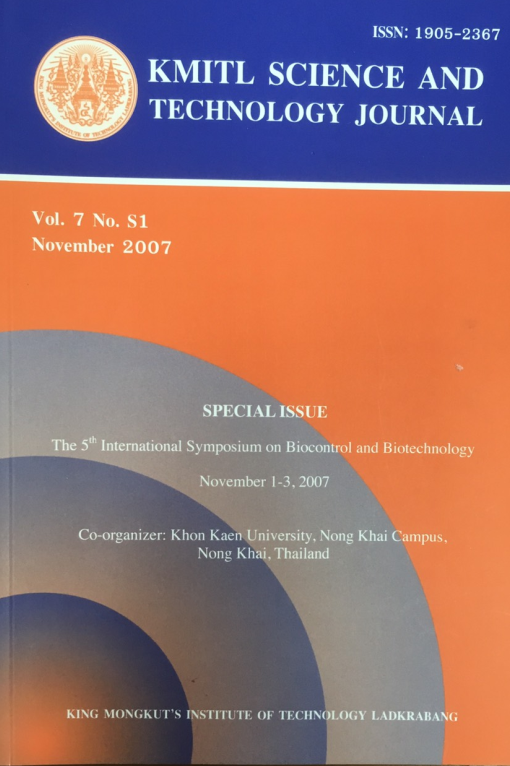PREPARATION OF RED YEAST RICE USING VARIOUS THAI GLUTINOUS RICE AND Monascus purpureus CMU001 ISOLATED FROM COMMERCIAL CHINESE RED YEAST RICE SAMPLE
Main Article Content
Abstract
A strain of Monascus purpureus CMU001 was isolated from locally available commercial Chinese red yeast rice (Ankak or Ang Khak) by surface sterile technique. The identity of the strain was then confirmed by conventional methods. Preparation of red yeast rice using isolated strain was carried out on various kinds of rice, and especially the most well known varieties of Thai glutinous rice such as Korkor 6 white glutinous rice (RD6), Kam black glutinous rice (Kam) and Sanpatong 1 white glutinous rice (SPT1). The red rice products obtained were studied for the intensity of red pigment by measuring the absorbance of red extracts at 500 nm. The results indicate the most intense red pigment when using RD6 with 3 week cultivation. In order to know the effect of nutrient variation, soybean milk was added during cultivation as amino acids source. The highest intensity was also expressed when RD6 was used with 2 week cultivation. The supplement of 1 ml of 0.25 g/ml soybean milk gave the product with more intense red color.
Keywords: Monascus purpureus, red pigment, red yeast rice
Corresponding author: E-mail: scboi009@chiangmai.ac.th
Article Details
Copyright Transfer Statement
The copyright of this article is transferred to Current Applied Science and Technology journal with effect if and when the article is accepted for publication. The copyright transfer covers the exclusive right to reproduce and distribute the article, including reprints, translations, photographic reproductions, electronic form (offline, online) or any other reproductions of similar nature.
The author warrants that this contribution is original and that he/she has full power to make this grant. The author signs for and accepts responsibility for releasing this material on behalf of any and all co-authors.
Here is the link for download: Copyright transfer form.pdf
References
[2] Hong, M.Y., Seram, N.P., Zhang, Y. and Heber, D. 2008 Anticancer Effects of Chinese Red Yeast Rice Versus Monacolin K Alone on Colon Cancer Cells, Journal of Nutritional Biochemistry, 19(7), 448-458.
[3] Erdogrul, O. and Azirak, S. 2004 Review of the Studies on the Red Yeast Rice (Monascus purpureus), Turkish Electronic Journal of Biotechnology, 2, 37-49.
[4] Pinthong, R., Baipong, S. and Raviyan, P. 2004 Effect of Monosodium Glutamate and Histidine on the Production of Red Pigment and Citrinin in Red Yeast Rice. Department of Food Science and Technology, Faculty of Agro-Industry, Chiang Mai University. Thailand.
[5] Pinthong, R., Rujanakraikran L. and Raviyan, P. 2000 Production of Pork Sausage Using Ankak to Produce Pigments, Journal Kaen Kaset, 28(2), 89-96.
[6] Andrea, B., Dionyz, M., Anna, L. and Monika, P. 2001 Utilization of Monascus purpureus in the Production of Foods of Animal Origin, Bull. Vet. Inst. Pulawy, 45, 111-116.
[7] Sabater- Vilar, M., Roel, F., Mass, R.F.M. and Fink-Gremmels, J. 1999 Mutagenicity of Commercial Fermentation Products and the Role of Citrinin Contamination, Mutation Research, 444, 7-16.
[8] Miche, L. and Balandreau, J. 2001 Effect of Rice Seed Surface Sterilization with Hypochlorite on Inoculated Burkholderia vietnamiensis, Journal of Applied and Environmental Microbiology, 67(7), 3046-3052.
[9] Domsch, K.H. 1980 Compendium of Soil Fungi Vol. 1, Academic press, London.
[10] Yongsmith, B. 1997 Microbiology of Vitamin and Pigments Fermentation. 1st ed., Kasetsart University, Thailand.
[11] Boonsangsom, J., Pinthong, R., and Raviyan, P. 2004 Effect of Monascus Fungi on the Amount of Citrinin in Red Yeast Rice. Department of Food Science and Technology, Faculty of Agro-Industry, Chiang Mai University, Thailand.
[12] Babitha, S., Soccol, C.R. and Pandey, A. 2007 Solid-State Fermentation for the Production of Monascus Pigments from Jackfruit Seed, Journal of Biotechnology, 98(8), 1554-1560.
[13] Yongsmith, B., Kitprechavanich, V., Chitradon, L., Chaisrisook C. and Buddha, N. 2000 Color Mutants of KB9 and Their Comparative Glucoamylases on Rice Solid Culture, Journal of Molecular Catalysis. B: Enzymatic, 10, 263-272.
[14] Singhapol, C. 2005 Red Pigment Production of Monascus purpureus TISTR3002 and Monascus purpureus TISTR3179 using Various Ingerdient. 31st Congress on Science and Technology of Thailand at Suranaree University of Technology, p. 121.
[15] Ottow, J.C.G. and Glathe, H. 1968 Rose Bengal-Malt Extract-Agar, A Simple Medium for the Simultaneous Isolation and Enumeration of Fungi and Actinomycetes from Soil, Journal of Applied Microbiology, 16(1), 170-171.
[16] Jarvis, B. 1973 Comparison of an Improved Rose-Bengal-Chlortetracycline Agar with Other Media for the Selective Isolation and Enumeration of Molds and Yeasts in Food, Journal Applied Bacteriology, 36(4), 723-727.
[17] Gamble, S.J.R. and Orcutt, F.S. 1951 Possible Use of Rose Bengal Agar as Differential Medium for the Isolation of Bacteria in the Family Rhizobiaceae, JournalBacteriology, 62(2), 247.
[18] Van Tieghem, M. 1884 Monascus genre nouveau de l’ondre des Ascomycetes, Bulletin de la Société Botanique. France, 31, 226-231.
[19] Went, F.A.F.C. 1895 Monascus purpureus, Le Champignon de l’Ang-quac, une Nouvelle Thelebolee, Annales des Sciences Naturelles, Botanique, 81, 1-8.
[20] Iizuka, H. and Lin, C.F. 1981 On the Genus Monascus of Asia and its Specific Characteristics In: M. Moo-Young, C.W. Robinson and C. Vezina, Editors, Advances in Biotechnology vol. 2, Pergamon Press, Toronto, pp. 555-561.
[21] Yongsmith B. 1999 Fermentative Microbiology of Vitamins and Pigments, 1st ed., Kasetsart University Press, Thailand.


